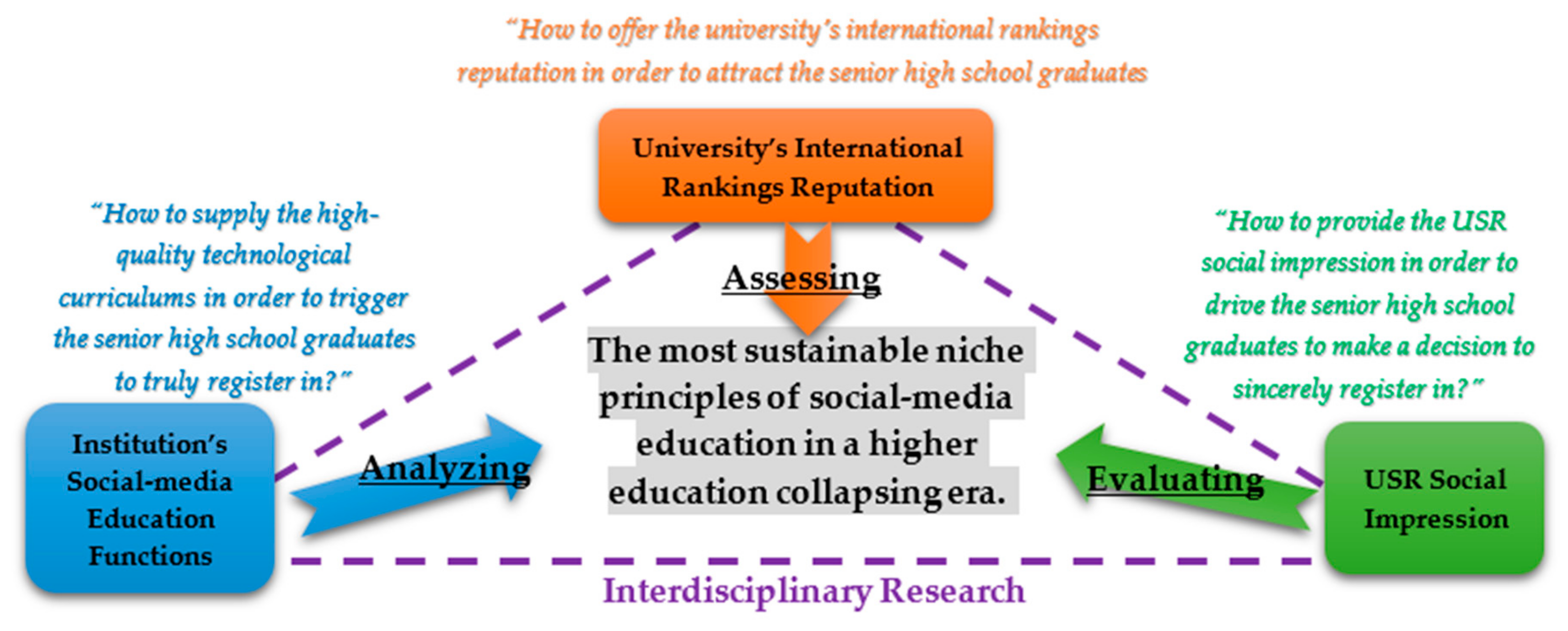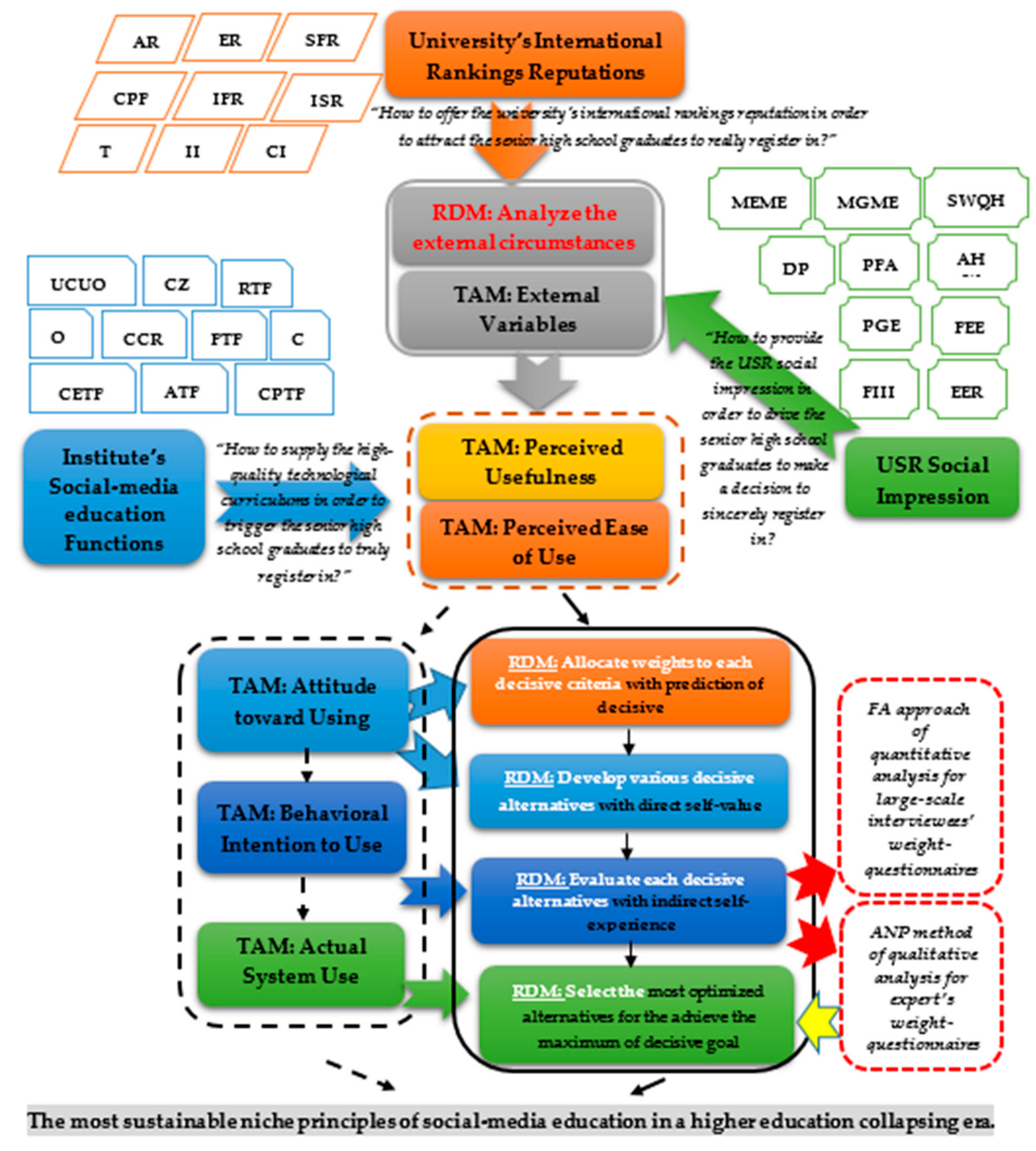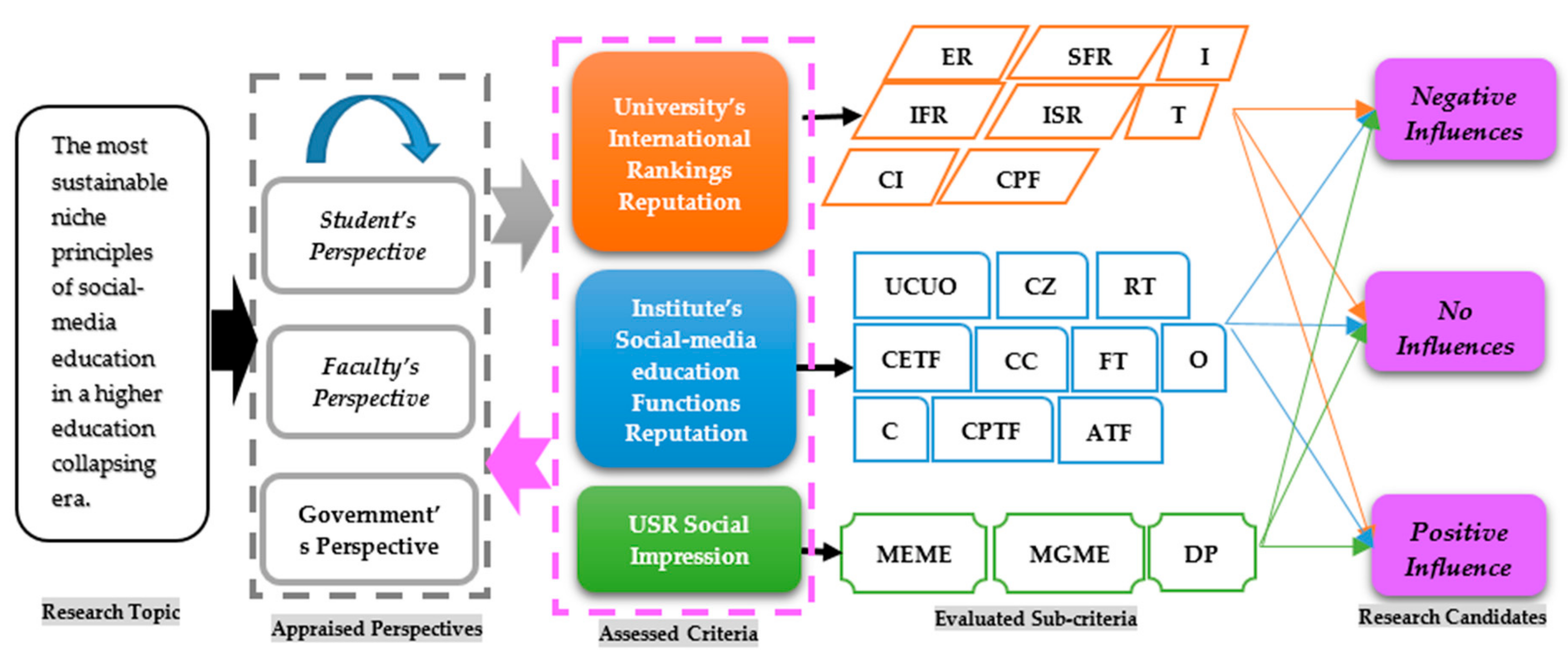1. Introduction
Due to the severely declining birth rate of new generations and the rapidly over-booming rate of higher education institutions, the number of Taiwanese higher education institutions has decreased to 157, compared with 162 institutions in 2019, and the percentage of higher-education-registered students in Taiwan in 2018 was only 85.6%, which means that these students decreased to 55,524 in 2018, according to the latest annual analytical freshman registration report by the Ministry of Education in 2019. In order to overcome this issue, the majority of Taiwanese higher education institutions have commenced creating a series of diversified social media education digital lecturing platforms to effectively increase the freshman registration rate. Specifically, the total number of higher-education-registered students in 2018 decreased by up to 47,000 compared with the number of registered students in 2008. Furthermore, according to the official annual report of the Ministry of Education in Taiwan, the declining birth rate has resulted in a rapid reduction of approximately 90,000 senior high school graduates from 2018 to 2028. Empirically, the number of senior high school graduates (24,349) decreased in 2019. Momentously, this number will decrease by approximately 10,000 and 12,000 in 2020 and 2021, which means that around 50,000 senior high school graduates will be cut from 2019 to 2021; however, the total number of recruited freshmen will only increase to 24,530 for 50 Taiwanese higher education institutions, which means approximately 50–60 Taiwanese higher education institutions have been forced to close. Therefore, a rivalry in the recruitment for talented students has started between Taiwanese higher education institutions. The number of Taiwanese foreign higher education students has increased up to 44,993, including 13,091 from Malaysia, 9006 from China, 7854 from Vietnam, 7695 from Hong Kong, 7347 from Indonesia, and some from the Middle East countries, such as Jordan, Israel, Yemen, Palestine, and so on. Specifically, in order to attract more talented foreign students to replenish the decreased registration gap due to the declining birth rate, the majority of Taiwanese higher education institutions have to set up a series of niche and sustainable development strategies in order to survive. Significantly, the characteristics of these strategies are not only the highest registration revenues but also the lowest operating costs. Subsequently, according to the rapid development of wireless and telecommunication technologies, an institution’s social media education functions have been the core determinants for contemporary hyper-technology generations in selecting higher education institutions. In succession, choosing a higher education institution is the most critical decision for each senior high school graduate. With the rapid development of social media technology in education, there are many technological 3C (computer, communication and consumer electronic) devices (such as computers, tablets, 3D devices (three-dimension printers), and platforms (such as Facebook, Apps (Digital Applications), etc.) that can be utilized in higher education institutions; especially, a bulk of contemporary Taiwanese students use many diversified technological 3C devices and platforms [
1]. For this reason, the five user’s essential elements of the technology acceptance model (“TAM”) are necessary when assaying this research topic. These elements are perceived usefulness, perceived ease of use, attitude toward using, behavioral intentions to use, and external variables [
2]. TAM was induced to discover users’ behavior patterns by appraising each technological influence factor in operating new social media technology [
3]. Therefore, in order to analyze the external circumstances of an institution’s social media education functions, TAM was utilized to detect the hyper-competitive technological generation’s accepted concepts, attitudes, and actions of a social media education institution [
4,
5].
Moreover, the basic concept of corporate social responsibility (CSR), after 2000, was addressed in the World Business Council for Sustainable Development report by Lord Holme and Richard Watts. Corporate operation is not only to contribute to the economy but also to improve the life quality of numerous employees and serve communities and society [
6]. Subsequently, after promoting CSR, university social responsibility (USR) commenced to encourage and advocate increased social benefits since the majority of higher education institutions in the USA, Canada, and Europe. Significantly, American and Canadian governments have concentrated on developed sustainability for their higher education institutions. The most excellent higher education institutions, including Harvard University, Yale University, University of Cambridge, University of London, etc., have started to develop a series of Green Energy Plans on campus in their environment research center in order to stimulate the students’ and faculties’ attention to environment protection [
7,
8]. According to the cities and regions in the new learning economy of the Organization for Economic Cooperation and Development (OECD), regional economy development comes from global participation and the connection between local knowledge and the economic co-relationship with regional universities. Therefore, the regional learning economy indeed needs regional universities to drive learning regions and learning cities toward regional economic development. In Europe, the European Union University Social Responsibility (EU-USR) states that European higher education institutions have responsibilities for constructing a series of public transparency strategies and actions to positively influence the environment and the entire society. These strategies and actions are as follows: (1) higher education institutions are able to cultivate in students the competencies for strengthening justice and fairness, democratic participation, and developmental sustainability [
9], (2) higher education institutions are able to continuously promote health and welfare [
10], (3) higher education institutions are able to take responsibility for stakeholders [
11], (4) higher education institutions are able to match the action standards of international USR rules and regulations [
12], and (5) higher education institutions are able to match the action standards of international USR rules, and regulations are conform to the responsible standards of public transparency and performance [
13].
The traditional research question: “do current Taiwanese senior high school graduates pay close attention to these assessed criteria and evaluate the weights of the four famous and accredited World University Rankings in selecting higher education institutions in an era of declining birth rates?” has been expounded as follows: “how can a university achieve an international rankings reputation to attract senior high school graduates to register?” [
14], “how can high-quality technological curriculums be supplied to attract senior high school graduates to register?” [
15], and “how can universities give the impression they engage in USR in order to attract senior high school graduates to register?” [
16]. In multidisciplinary associations, there are three influencing dimensions (the university’s international reputation, the institution’s social media education functions, and the USR impression), and students are choosing higher education institutions. These three core research questions not only directly determine students’ original decisive motivation-driven factors to register higher education institutions but also positively identify the niche principles of survived sustainability in the higher education era from three aspects: the university’s international rankings reputation, the institution’s social media education functions, and the USR impression, as described in
Figure 1.
However, by making a comprehensive survey on the relative research, it is evident that no one research was able to completely assay the co-relationships and interdependences among three influencing dimensions: university’s rankings international reputation, institution’s social media education functions and USR social impression. Therefore, this research not only systematically employed a Rational Decision-making Model (“RDM”) and TAM to interactively construct the most effective evaluation mode but also statistically applied a Factor Analysis (“FA”) approach of quantitative analysis to verify the large-scale students’ weight-questionnaires but also a hierarchical Analytical Network Process (“ANP”) method of qualitative analysis to testify the professional experts’ weight-questionnaires with respect to higher research reliability and validity in order to explore from an interdisciplinary perspective the most sustainable niche principles of social media education in a higher education contracting era.
5. Conclusions and Recommendations
In view of recent higher education contracting because of the declining birth rate, explosive formation of social media technology and the swift development of higher education, the majority of higher education institutions have dedicated to explore the most sustainable niche principles of social media education in a higher education contracting era. Therefore, this research, from student’s, faculty’s and government’s appraised perspectives, not only systematically cross-employed TAM and RDM methodology to an in-depth discussion of the co-relationships among the assessed criteria and evaluated weights of four famous and accredited World University Rankings, the most potential features of MOOCs and SDGs of USR but also hierarchically cross-applied FA approach of quantitative analysis and ANP method of qualitative analysis to comprehensively assay the evaluated measurements of random large-scale weight-questionnaires of students and professional experts.
After a series of systematic and hierarchical evaluation-measurements, the four most valuable contributions were presented in consideration with three mainstream research questions, the most contributive conclusions for the three core research questions were:
Not only did “USR social impression” positively influence the “survived sustainability of higher education institutions” but also the Making Education More Equitable (MEME), Diminishing Poverty (DP) and Making Gender More Equality (MGME) initiatives are the most sustainable niche principles of social media education in a higher education contracting era during a hyper-technology generation when selecting higher education institution.
The top most evaluated scale of sub-criteria in the assessed criteria (University’s International Rankings Reputation) is industry income (II) (0.043) of THE (Times Higher Education) World University Rankings because the majority of hyper-technology generation students have paid more attention to the industrial impression of higher education institutions in order to strengthen employability after graduating from higher education institutions. Therefore, “the increment of industry income from higher education institutions” is the best answer for the research question: “how to offer university’s international rankings reputation in order to attract senior high school graduates to really register?”
The most top evaluated scale of sub-criteria in the assessed criteria (Institution’s social media education functions) is the aggregation technology function (ATF) (0.043) of the most potential features of MOOCs because the majority of hyper-technology generation students have diversified the aggregation of technology functions into the institution’s software and hardware in social media education in order to advance self-learning interests. For this reason, “the addition of the aggregation technology function (ATF) in various social media education software and hardware” is the best answer for research question: “how to supply high-quality technological curriculums in order to trigger senior high school graduates to truly register?”
The most top evaluated scale of sub-criteria in the assessed criteria (Institution’s social media education functions) is Making Education More Equitable (MEME) (0.5166) of SDGs of USR because the majority of hyper-technology generation students have focused on the USR in educational equitability of higher education institutions in order to facilitate educational popularization of entire society. Hence, “the facilitation of education equitability in USR” is the best answer for research question: “how to provide the USR social impression in order to drive senior high school graduates to make a decision to sincerely register?”
As a result, the higher education institutions necessarily provide the aggregation technology function (ATF) in institution’s social media education for not only fulfilling Making Education More Equitable (MEME), Diminishing Poverty (DP) and Making Gender More Equality (MGME) of institution’s USR but also increasing the industry income (II) of THE (Times Higher Education) World University Rankings in order to attract, trigger and drive students to make a decision to sincerely register. Materially, the most valuable findings of this research are directly proving that the current higher education USR policies of “USR social impression” does positively assist in lowering the recruiting-rate and registering-rate of each higher education institutions as well as eventually accelerating the educational equitability of an entire society. Subsequently, in terms of research limitation, the more data-collection and methodologies are expected to be employed in future related research after the completion of this research although the random large-scale and professional questionnaire and quantitative and qualitative analyses have been executed in this research. However, the contributive conclusions and valuable findings do academically supply an interdisciplinary research gap among university’s rankings international reputation, institution’s social media education functions and USR social impression as well as empirically provide the most sustainable niche principles of social media education in a higher education contracting era.











